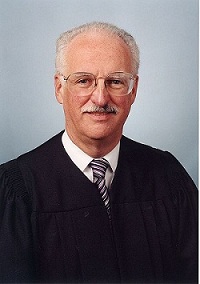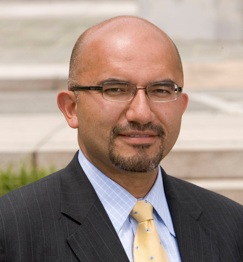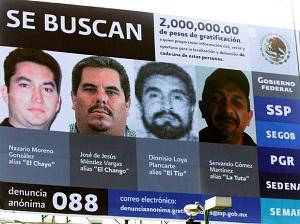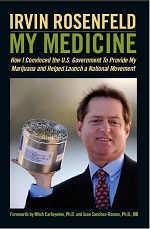Help bring about the brighter future that awaits us beyond prohibition, by making a tax-deductible educational donation or a non-deductible lobbying donation before year's end.
Can the cops put a GPS device on your car and track you for weeks without a warrant? That's what they did to DC club owner Antoine Jones. Now, after a federal appeals court sided with Jones, his case could be headed for the Supreme Court.
Psychiatrist Christopher Fichtner makes a real contribution to the literature with Cannabinomics. You should check it out, or, better yet, give it to someone who is genuinely curious about how best to handle marijuana.
More major drug trafficking figures were captured or killed this week, yet Mexico's drug prohibition-related violence continued unabated. This year's death toll has passed 9,000, and Ciudad Juarez this week passed the 3,000 mark.
A narc who admits he's corrupt, a narc accused of serial theft, an auxiliary cop busted for peddling pills, and a deputy who thought he was protecting dealers all made the roll of dishonor this week.
New Jersey Gov. Chris Christie claims to support medical marijuana, but has acted first to delay the law there, then to subvert it through the regulatory process. Now, the state Senate has told him to get real.
An Alabama medical marijuana nightmare is about to come to an end for a card-carrying California patient.
Three senators have introduced a bill to set up a commission to evaluate the efficacy of US anti-drug programs in the hemisphere. But is it about ending the war on drugs or just making it more efficient?
The annual Monitoring the Future survey of teen drug use is out. Teen pot smoking is up slightly, but in line with most of the past 15 years.
Salvia divinorum is a powerful, short-acting hallucinogen, but it won't adversely affect your health -- at least in the short term -- a new study has found. Just don't go out driving on it, please.
Events and quotes of note from this week's drug policy events of years past.
Dear StoptheDrugWar.org reader:
| |  |
| |
If you have been following Drug War Chronicle or our Speakeasy blog, you have a sense for why drug reformers believe that a brighter future beyond prohibition is ahead of us. We've reported on California's Prop 19 marijuana legalization initiative -- the positive media coverage it got, the new allies it brought in, the closeness of the vote in a year that favored conservative election turnout. We've talked about polling results showing national support for legalization approaching the 50% mark. And many other positive developments here and around the world as well. Our time will be here soon.
I've also written here about the phenomenal success that our newly-redesigned web site has had in its first few months. The improved site, our more up-to-the-minute publishing, and the excitement of Prop 19, all combined to bring more than half a million people to StoptheDrugWar.org during the weeks leading up to the election. We are taking the anti-prohibitionist message to more people than ever.
If you are doing tax-deductible, charitable giving in 2010, would you be willing to include our educational nonprofit, DRCNet Foundation, among the organizations you are supporting? If you're not doing tax-deductible donating at this time, would you instead make a non-deductible donation to our lobbying nonprofit, Drug Reform Coordination Network? Please consider making generous donations to one or both of these entities at this important time.
| |  |
| |
We are pleased to offer three new membership premium gifts, reflecting our optimism for the future:
- Cannabinomics: The Marijuana Policy Tipping Point, book by Dr. Christopher Glenn Fichtner, points the way to a brighter future beyond the current drug war. (See our review of Cannabinomics here.)
- Emperor of Hemp, a re-released memorial tribute edition of the classic video, honors the movement pioneer Jack Herer whose efforts enabled much more to follow. (See our review of Emperor of Hemp here.)
- My Medicine, by Irv Rosenfeld, tells his story as one of now only four patients in the federal government's medical marijuana program, and chronicles the history of medical marijuana as it's unfolded in the US to its incredible place today.
Donate $15 or more for Emperor of Hemp, $35 or more for Cannabinomics or My Medicine, $45 for the video and either book, $60 for both books, or $75 or more to get all three.
Resources are tight in the drug policy reform movement right now, despite the excitement of the election. At StoptheDrugWar.org we have therefore focused our efforts on the work that we're the best at -- high-quality, journalistic level, original publishing about the drug war; and using our web site and email list to grow and support the entire drug reform movement -- Prop 19, sentencing reform, medical marijuana in the many states, everything.
We have made huge strides, and reform activists from the rank-and-file up through the leadership tell us what a difference our work makes for them.
But because the economy and funding situation is what it is, we need your help as this special year draws to a close -- please make a generous donation supporting StoptheDrugWar.org today.
Sincerely,
David Borden, Executive Director
StoptheDrugWar.org
Washington, DC
http://stopthedrugwar.org
P.S. We are grateful for your donation, whether it's large or small -- believe me, even the small ones add up to make a difference!
P.P.S. If you'd rather donate by check, select the "mail-a-check" option in our donation form, or send a check payable to DRCNet Foundation (tax-deductible for our educational work) or Drug Reform Coordination Network (non-deductible, supports our lobbying work) to P.O. Box 18402, Washington, DC 20036.
back to top
Special to the Chronicle by Clarence Walker
[Editor's Note: Houston-based Clarence Walker has spent more than two decades as an investigative crime journalist, associate producer for cable TV criminal justice shows, and stringer for wire services. He has also published extensively in daily and weekly newspapers in Texas and New York, and legal journals. Look for more on GPS surveillance and the Antoine Jones case, including a full-length interview with the current Supermax resident, in the next week or two.]
In an August ruling that created a split with federal circuit courts in New York and California, the US Court of Appeals for District of Columbia became the first in the land to hold that police cannot use a Global Positioning System (GPS) device to track a person's movement for an extended period of time without a warrant.

Police placed a warrantless GPS Tracking Device on Jones' vehicle.
Just three weeks later, the 9
th US Circuit Court of Appeals in San Francisco upheld warrantless GPS tracking in similar circumstances. Given the rifts in the federal circuit courts, and now, among the differing appeals courts, the issue is almost certainly headed for the US Supreme Court for resolution.
The DC ruling in
US v. Lawrence Maynard came in the case of two conjoined defendants, Lawrence Maynard and Antoine Jones, who were convicted of cocaine conspiracy offenses in the DC district court. Jones, the owner of a Maryland night club, had been targeted by the FBI and other federal and state police agencies as a major player in a multi-million dollar cocaine ring with ties to a Mexico-based organized crime group. Investigators said Jones and his co-conspirators distributed cocaine throughout the DC metro area.
In September 2005, Judge Paul Friedman of the federal district court issued a warrant for the FBI to install a GPS device on the Cherokee Jeep that Jones drove. For unknown reasons the investigators allowed the GPS warrant to expire, rendering it invalid. Why agents never requested another warrant remains unclear, but they went ahead and placed a GPS on Jones' vehicle.
The warrantless GPS produced 3,106 pages of data showing the movement of the vehicle at 10-second intervals. US attorneys said the data evidence placed Jones at a Fort Washington, Maryland residence where FBI in 2005 recovered 97 kilos of cocaine and almost a million dollars. Jones was arrested the same day of the raid and held without bond on multiple drug trafficking and conspiracy charges.
The first trial went disastrously for prosecutors. Jurors in the case handed down numerous acquittals and deadlocked on multiple other charges. After the trial, jurors told the
Washington Post that the government had failed to prove its case. They wondered why none of the defendants were caught with or near the kilos of cocaine worth millions and why neither Jones nor his associates were ever photographed at the location where the drugs were found. And they questioned the GPS evidence, which they said only placed Jones' vehicle in the immediate area.
While Jones was acquitted of the most serious charge of conspiracy, he remained in jail pending retrial on the remaining charges. The feds did better the second time around. Using the same GPS and informant evidence as in the first trial, they managed to convince a jury to convict Jones this time. He was sentenced to life in prison, and currently resides in the federal Supermax prison in Florence, Colorado, as he awaits a government appeal of the August appeals court ruling.
In that decision, federal Judge Douglas Ginsburg, writing for a unanimous three-judge panel, held that the warrantless use of such surveillance technologies violates constitutional protections against warrantless searches. The heart of the ruling concerned a person's privacy expectation irrespective of the criminal nature involved.

Federal Appeal Court Judge Douglas Gingsburg voted to overturn Antoine Jones' conviction.
"It is one thing for a passerby to observe or even follow someone during a single journey as he goes to the market or returns home from work. It is another thing entirely for that stranger to pick up the scent again the next day and the day after, week in and week out, dogging his prey until he has identified all the people, amusements, and chores that make up that person's hitherto private routine," Ginsburg wrote.
Government prosecutors argued the extended surveillance -- 28 days worth of GPS tracking without a warrant -- did not violate Jones's right to a reasonable expectation of privacy because he had been traveling in full view on public roads. In so doing, they relied on the Supreme Court's decision in
US v. Knotts, which held that police could legally track a suspect's car electronically without a warrant.
Other circuit courts have interpreted the Knotts decision to allow extended surveillance. But the DC panel held that relying on Knotts to approve extended warrantless surveillance was a misreading of the case because the Supreme Court had reserved its opinion on whether such tactics could be used in full-time, "dragnet-type" surveillance.
Although in the minority in the 9
th Circuit case later that month, Judge Alex Kozinski strongly agreed with his brethren on the DC appeals court. "By holding that this kind of surveillance doesn't impair an individual's reasonable expectation of privacy, the panel hands the government the power to track the movements of every one of us, every day of our lives," he wrote in a stinging dissent.
The DC appeals court ruling was welcomed by civil libertarians, defense attorneys, and the Electronic Frontier Foundation and the American Civil Liberties Union (ACLU), which filed amicus briefs arguing that a warrant should be required for GPS tracking.
"Today's decision brings the Fourth Amendment in the 21st century," said Arthur Spitzer, legal director of the ACLU.
"This is the first decision on the federal appellate side that's really given momentum to the requirement for a warrant," said Washington, DC, attorney Daniel Prywes.
"The big picture is if the court allows warrantless GPS, it will take us one giant step closer to a surveillance society and that much further away from a free society," said ACLU attorney Bryan Caves. "Warrantless GPS would allow police anywhere to track a person's movement over an extended period of time without judicial supervision. And that's scary."
The lawyers weren't the only ones happy with the decision. "I was overwhelmed with happiness" when the verdict came in, said Antoine Jones. "But the first time in my life I got brain lock! When I read my appeal attorney's email and it said, 'We won!' I had to call one of my homies and asked him to email my wife and my loved ones because I lost it. I had to go and pray, thanking God to get it back together."
But unless and until the US Supreme Court decides the GPS tracking issue in his favor, Antoine Jones remains inmate number 18600-016 at the Florence Supermax. Journalist Clarence Walker interviewed him over a matter of weeks via email and phone calls this fall. Jones continues to fight to see the light of day and decries what he called a rigged trial.
"The next step is to see if the government will appeal the decision," he said. "If the appeal is forwarded to an en-banc hearing, my attorney, Stephen Lecklar, said he doesn't think the government will get a favorable ruling because the three-panel judges has already ruled in my favor."
Jones said the government might bypass the en-banc hearing and appeal to the Supreme Court."So if the government doesn't appeal the reversed decision, I will be released immediately." Jones added that if the Supreme Court affirms the reversal, "It will crush the government because all 50 states would require police to get a warrant before they can place an electronic device on vehicles."
Jones did not receive a fair trial, he said. "It would take days to explain all the misconduct by the government and how I was punished with prejudice in both trials. I have five civil complaints dealing with this case and I am going to win," he predicted. "Without the trial judge's prejudice against me the government wouldn't have had a chance and I would have walked free during the first trial -- or at least, the case would have been dismissed in pretrial."
Jones pointed to an admitted warrantless search of his apartment by federal agents. "Once the agent admitted this error, Judge Huvelle should have ruled in my favor, but she didn't rule to avoid a mistrial. That violation alone should have caused a mistrial or acquittal."
"To make matters worse the agents also entered my house illegally with a key and the judge wouldn't allow my wife or son to testify to the illegal search which allowed me to get convicted on this prejudiced evidence," Jones said.
Nor was Jones impressed by the quality of justice in the federal courts, and he aimed his broadside at the defense bar, as well as prosecutors and the judiciary. "These days the feds don't have to try to get you to roll over on your co-defendants," he said. "They get the high-paid shyster lawyers to do their dirty work. I explained to my attorney in the beginning of the case that I was going to war and I didn't want to hear what the government had to say or offer."
What the lawyers are doing in DC District Courts is coercing their clients to attend a "reverse debriefing" whereby the government will present evidence from a case, Jones explained. "And then the government and defense attorneys manipulate and encourage the defendant to work with the government or take a plea."
Lawyers for some of the co-defendants in the case decided to snitch for the feds. Jones recalled how the tactics backfired. "Almost all of my co-defendants and their lawyers tried to get them to flip on me but those who declined and went to trial with me the first time, they were acquitted. But two of my co-defendants attended the debriefing and testified against me. They went to prison but the other three who declined to testify went home."
As he awaits his freedom, Jones said he relied on faith and family to see him through. "The only thing that keeps me going is the grace of God, his protection and my family support," he said. "I am at the US federal prison in Florence, Colorado, and this place is a living hell!"

Attorney A. Eduardo Balarezo represented Jones during trial.
Jones' trial attorney, Washington-based Eduardo Balarezo, confirmed most of Jones' story. While he would not agree that some officers perjured themselves at trial, he added, "Although I think some of them massaged the truth a little bit."
Balarezo didn't think much of the government's stated reason for failing to obtain a warrant before GPSing Jones' vehicle. "The government basically said that getting a warrant would be onerous and not necessary, yet they were able to get one, but then let it expire and still placed it on my client's car," he noted.
Now, Jones may help make history as, one way or another, the warrantless GPS tracking issue makes its way to the Supreme Court. The former DC club owner is ready to start fresh once given the chance to walk out the prison doors.
"If the Lord blesses me to prevail and get my freedom, I will educate the youth and give back to the community," he said. "The real story is to put the past behind me and do the Lord's work to help others and save our youth."
back to top
Drug War Chronicle Book Review: "Cannabinomics: The Marijuana Policy Tipping Point," by Christopher Glenn Fichtner, MD (2010, Well Mind Press, 345 pp., $29.95 HB)
(Order this and other new membership premiums by donating to StoptheDrugWar.org.)
Cannabinomics? That is simply Chris Fichtner's eye-grabbing term for managing our relationship with cannabis. Or it is cannabis science, cannabis policy, and cannabis economics. Or, more broadly, it is the development of the vocabulary that will allow us to move from pot prohibition to regulation.
I read lots and lots of books about marijuana policy -- it's part of my job -- and I have to say that Cannabinomics is one of the most gratifying I've seen in a long time. While Fichtner covers a lot of familiar territory -- the increasing acceptance of medical marijuana, the amazing stupidity of and harms derived from pot prohibition, the economic potential of marijuana -- he does so in a manner that is both fresh and exceedingly well thought out.
Fichtner is an MD, a psychiatrist, and public mental health specialist who has served, among other posts, as the Illinois state mental health director. As such, he brings a powerful professional focus to marijuana and health and marijuana and mental health. But equally as valuable, he brings with him a calm, considered, and compassionate approach to the Gordian Knot of issues that surround cannabis in our society.
In fact, I would have to say that if I had to choose a single title dealing with marijuana policy to give to someone new to the conversation, I'd have to go with Cannabinomics. Fichtner is cautious and even-handed -- he is, after all, a psychiatrist, not a wild-eyed pamphleteer -- and that makes his carefully considered judgments all the more powerful.
As a practicing psychiatrist, Fichtner has had ample opportunity to see how medical marijuana (or, as he prefers, therapeutic cannabis) has worked for some of his patients. Cannabinomics includes several abbreviated case histories of patients who, on their own, turned to medical marijuana to relieve symptoms ranging from epileptic seizures to depression to PTSD. That provides him with an opportunity to tout "consumer-driven health care" -- in other words, listening to patients about what actually works for them.
That is at odds with the prevailing model of scientific research on medicines, which relies on rigorous, large sample, carefully-designed testing. As Fichtner notes, there is nothing wrong with such testing, but it should not be exclusively relied on at the expense of real world patient experience. If a patient reports that carefully titrated use of marijuana reduces the frequency of his seizures, it does no one any good to retort that such findings are not supported by the scientific data.
Of course, marijuana is funny that way. It's not a medicine in the eyes of Western medicine because it's not a synthesized and standardized concoction available in pill form from a major pharmaceutical company. In fact, Fichtner suggests that perhaps marijuana should not be treated as a medicine but as an herbal, or traditional medicine. He also wonders, quite convincingly, whether health care in the US is driven more by the needs of pharmaceutical companies than those of human beings.
But while Cannabinomics begins with medical marijuana, it isn't just about medical marijuana. Fichtner also discusses the history and results of marijuana prohibition in the US. Unsurprisingly, like every even-handed observer on the topic, he finds prohibition to be a disaster, both in terms of public policy and in terms of wasted opportunities. He doesn't cover a lot of new ground there, but he does calmly and dispassionately make the case that pot prohibition is one of the great policy failures of the 20
th Century.
He doesn’t want it to be one of the great policy failures of the 21
st Century, and the final section o Cannabinomics is devoted to getting us off the schneid when it comes to actually enacting real marijuana law reform. Fichtner has some concrete recommendations for that: a federal cannabis regulatory commission, the federal government to become a cannabis purchaser, a pilot program granting veterans access to medical marijuana through the VA, fast-track approval of Sativex, opening the cannabis trade to legal entrepreneurship, and allowing the states to experiment with new licensing processes for age-restricted substances, including alcohol and tobacco.
Cannabinomics is a humane, thoughtful, and powerful look at how we as a society can better deal with one of our most popular -- and least harmful -- substances. It should be especially useful in bringing those who are not pot advocates but who have a genuine concern about what the best marijuana policies might look like into the discussion. And that makes it a very important work indeed.
(Order this and other new membership premiums by donating to StoptheDrugWar.org.)back to top
by Bernd Debusmann, Jr.
Mexican drug trafficking organizations make billions each year smuggling drugs into the United States, profiting enormously from the prohibitionist drug policies of the US government. Since Mexican president Felipe Calderon took office in December 2006 and called the armed forces into the fight against the so-called cartels, prohibition-related violence has killed more than 30,000 people, including more than 9,000 this year. The increasing militarization of the drug war and the arrest of dozens of high-profile drug traffickers have failed to stem the flow of drugs -- or the violence -- whatsoever. The Merida initiative, which provides $1.4 billion over three years for the US to assist the Mexican government with training, equipment and intelligence, has so far failed to make a difference. Here are a few of the latest developments in Mexico's drug war:

La Familia wanted billboard, "El Chayo" on left
In Michoacan, authorities killed Nazario "El Chayo" Moreno, the head of La Familia Michoacana (LFM). Moreno, 40, also known as "the Craziest One", was killed during large scale fighting which took place after authorities attempted to raid a party between thrown by LFM. Fighting spread to at least 12 other cities of the state, and many major highways were blocked by vehicles which had been hijacked by gunmen. Casualty figures are still unclear, but at least five police officers and three gunmen were killed.
Saturday, December 11
In Ciudad Juarez, at least 14 people were murdered in a 24-hour period. The incidents include at two mass shooting in which a total of eight people were killed. No arrests have been made in those incidents.
In the town of Tecalitan, near Guadalajara, 13 people were gunned down at a party in honor of Virgin of Guadalupe. At least 30 people were wounded in the attack, in which gunmen used automatic weapons and fragmentation grenades.
Sunday, December 12
In Ciudad Juarez, at least ten people were murdered in several incidents in the city. Among the dead was a 14-year old boy who was shot along with two others by a group of heavily armed gunmen.
Monday, December 13
In Chihuahua, a Sinaloa cartel boss was arrested and his brother was shot dead in the town of Delicias during an operation conducted by 800 military and police personnel. Enrique Lopez was believed to be a local commander for the Sinaloa Cartel, led by Joaquin "El Chapo" Guzman.
Tuesday, December 14
In Ciudad Juarez, the death toll for 2010 surpassed 3,000 on Tuesday afternoon. Among the incidents on Tuesday was a triple homicide of three people shot dead on the street. Another Ciudad Juarez newspaper is reporting that the death toll is close to 3,100, although the total number -- including those who have disappeared -- is likely much higher. October was the most violent month, with 400 confirmed homicides, followed by August with 380 and June with 342.
Wednesday, December 15
Near Rio Rico, Arizona, a border patrol agent was shot and killed after encountering several suspects in the desert. Four suspects are in custody and at least one remains on the run. It is unclear whether the men were drug traffickers or not.
Total Body Count for the Week: 147
Total Body Count for the Year: 9,654
Read the previous Mexico Drug War Update here.
back to top
A narc who admits he's corrupt, a narc accused of serial theft, an auxiliary cop busted for peddling pills, and a deputy who thought he was protecting dealers all made the roll of dishonor this week. Let's get to it:

drug cash can corrupt cops
In Philadelphia,
a Philadelphia narcotics officer has been jerked off the streets after being accused for the third time in as many years of stealing money from people he accosted. Officer Joseph
Sulpizio, a member of the Strike Force North dope squad, is now accused of detaining a man, driving him to a remote location, and then stealing $500 from him before letting him go. He is scheduled to go before a Police Board of Inquiry next month. At least two high-ranking narcotics supervisors have repeatedly complained to the Internal Affairs Bureau that
Sulpizio might be a rip-off artist. If internal affairs can't figure it out, the neighborhood where he patrols already knows the score. "Everybody in the neighborhood knows he's stealing," one resident said.
In New Lexington, Ohio,
a Somerset police auxiliary officer was arrested December 7 for peddling Oxycontin. Auxiliary officer Joseph Daley, 33, was arrested at his home after an investigation that began in February. Daley sold to an undercover officer and then was arrested. He is charged with one count of aggravating drug trafficking with a gun specification. He was being held on a $50,000 bond in the Muskingum County Jail at last report. Oh, and he's been fired from his auxiliary officer gig.
In Houston,
a former Harris County sheriff's deputy was indicted by a federal grand jury last week on charges he took $1,000 in bribes to help protect what he thought were Ecstasy shipments. George Ellington,
Jr., 38, is charged with two counts of extortion under color of official right, two counts of aiding and abetting the possession with the intent to distribute Ecstasy, and two counts of carrying or possessing a
Glock .40 caliber pistol to further a drug trafficking crime. He was originally arrested October, but the federal grand jury has updated the charges. He is out on $50,000 bond.
In Providence, Rhode Island,
a Providence narcotics officer pleaded guilty December 9 to peddling cocaine and assisting a "large-scale cocaine distribution ring" led by one of his confidential informants. Detective Joseph Colanduono, 45, pleaded guilty to two counts of conspiracy to deliver drugs, larceny, and harboring a criminal. He faces up to 10 years in prison when he is sentenced next month. Colanduona was one of four Providence police officers and at least 25 others charged in a joint investigation of the ring by the Rhode Island State Police and the FBI. He worked on a DEA task force until he was arrested.
back to top
The New Jersey Senate Monday sent Gov. Chris Christie's (R) proposed medical marijuana regulations back to the drawing board. The Senate passed a resolution rejecting the draft regulations, and the state Department of Health and Senior Services now has 30 days to come up with regulations that actually fit with the state's Compassionate Use Medical Marijuana Act as passed by the legislature and signed into law at the beginning of this year.

The State Senate steps up to protect the medical marijuana law. (image from wikimedia.com)
Although it has been eleven long months since the act became law, Gov. Christie and his administration have been dragging their feet. First, Christie sought a delay in implementing the law and won a three-month reprieve from the legislature. Then, the administration released its draft regulations in October, only to be met with strong criticism from patients, advocates, and legislators. The regs were criticized for conflicting with the law as passed and being so restrictive as to make the program unworkable.
Last week, Assemblyman Reed Gusciora (D-Princeton), one of the key sponsors of the law, announced he had struck a deal with Christie, but that
Faustian bargain was roundly criticized by patients and other legislators alike. Medical marijuana supporters in the state Senate refused to accept the deal, and Monday made that rejection official.
The New Jersey medical marijuana law was already the most restrictive in the nation before the Christie administration moved to make it even more so. It allows patients suffering from certain debilitating and life-threatening illnesses such as cancer, HIV/AIDS, and multiple sclerosis to use and possess medical marijuana with a doctor’s recommendation. It calls for the licensing of Alternative Treatment Centers where qualifying patients could safely access medical marijuana.
The Senate criticized four specific provisions of the regulations that are "not consistent with the intent of the legislature as expressed in the language of the Compassionate Use Act," including the requirement all qualifying medical conditions for which a patient may get medical marijuana be resistant to conventional medical therapy. In the original legislation only certain medical conditions were required to meet this threshold.
It also rejected the limit of two Alternative Treatment Centers that will grow medical marijuana and four that will dispense marijuana. The original bill called for at least two Alternative Treatment Centers in the north, central and southern parts of the state.
And it rejected the draft regulations' arbitrary limit on the permissible levels of THC the medical marijuana may contain. There was no such restriction in the original bill.
Finally, it objected to the two year waiting period mandated by the regulations before patients can petition to have new conditions added to the list of conditions for which medical marijuana can be accessed. No such waiting period was included in the original legislation.
"We urge the department to move swiftly to change the problematic sections of the regulations," said Roseanne Scotti, director of the
Drug Policy Alliance New Jersey, which spearheaded the effort to pass the legislation. "We are approaching the one year anniversary of the bill becoming law and patients are still suffering and still no closer to having safe and legal access to their medicine."
"I’m tired of fighting for what I deserve," said Diane Riportella, who suffers from ALS (also known as Lou Gehrig's Disease). "I don't have much time left and want to see this program started before I'm no longer here."
Also playing important roles in passing the medical marijuana law and ensuring that it is implemented in accordance with the will of the legislature were the Coalition for Medical Marijuana-New Jersey, the New Jersey Academy of Family Physicians, the New Jersey League for Nursing, the American Civil Liberties Union of New Jersey, the New Jersey State Nurses Association, the New Jersey chapters of the Leukemia and Lymphoma Society, Faith is Our Pathway, and the New Jersey Hospice and Palliative Care Organization.
Now, the clock is ticking on the Christie administration. Its delays have been used up, its overly restrictive regulations have been rejected, and now it is time for it to just buckle down and do the right thing.
back to top
A California medical marijuana patient facing up to 10 years in prison in Alabama for possessing five grams of marijuana will now go free. In court proceedings in Anniston Monday, Michael Lapihuska agreed to a plea deal in which he was sentenced to two years of unsupervised probation, with no drug testing. He is now free to leave Alabama, and will most likely do so within a matter of days. (See our earlier feature article on Lapihuska and his travails here.)

Get out of Dixie, Michael! (Lapihuska facing camera, image courtesy Alabamians for Compassionate Care)
An Alabama native, Lapihuska left the Heart of Dixie several years ago after serving 13 months in prison for possessing five grams of marijuana in 2003. Lapihuska, who suffers from depression and Post-Traumatic Stress Disorder (PTSD), headed for greener pastures in California, where he became a card-carrying medical marijuana patient, but came home last December for a holiday visit.
On December 15, 2009, he was stopped by a police officer and accused of hitchhiking as he walked down a road. The officer demanded he be allowed to search Lapihuska, and Lapihuska complied. The search came up with a prescription bottle containing one gram of marijuana. Lapihuska explained that he was a registered California medical marijuana patient and produced a patient ID card.
But Alabama justice doesn't recognize medical marijuana, and Lapihuska was charged with his third marijuana possession offense, this one worth between two and 10 years in state prison. Under Alabama law, a first marijuana offense is a misdemeanor, but a second possession offense is a felony punishable by a year in prison. A third possession offense is a felony punishable by two to 10 years in prison.
Lapihuska's predicament soon won him the support of Alabama drug reform activist Loretta Nall and
Alabamians for Compassionate Care, who unleashed a media campaign in the local press to gain support for Lapihuska and to try to shame local prosecutors into reducing the charges.
Lapihuska didn't make it easy. Determined not to once again be caught up in the tender mercies of the Alabama criminal justice system, Lapihuska rejected a a plea deal that would have seen him sentenced to probation, but also subject to drug testing. He told the Chronicle he would fail such a test because he continues to use marijuana to treat his symptoms.
At the Monday court hearing, prosecutors lowered the felony marijuana count to a misdemeanor and allowed Lapihuska to plead guilty to that count and an original misdemeanor possession count. Lapihuska must pay a $250 fine on each count, but that is effectively it.
"We beat them down," said Loretta Nall, Lapihuska's most effective and energetic backer. "They didn't want the media attention. They just wanted him out of there. The judge even asked if he was really going back to California."
Nall added that Lapihuska was going to get out of Alabama if she had to buy his plane ticket herself.
Even in Alabama, a little activism can go a long way. What looked like an obscene 10-year prison sentence has now been transformed into a token conviction, a token fine, and an invitation to go home.
back to top
US Senators Patrick Leahy (D-VT), Robert Menendez (D-NJ), and Dick Lugar (R-IN) last Wednesday introduced a bill that would create an independent commission to evaluate US policies and programs aimed at reducing the supply of and demand for illegal drugs in the Americas. Similar legislation sponsored by Reps. Elliot Engel (D-NY) and Connie Mack (R-FL) passed the House one year to the day earlier.
The bill, the
Western Hemisphere Drug Policy Commission Act of 2010, also known as SB 4001, would also require that the commission recommend a multiyear anti-drug strategy to address what the members called "the escalating security crisis in the hemisphere fueled by the illicit narcotics trade." That strategy will "describe the assistance required to achieve regional counternarcotics goals and methodology for countering shifts in production and transit routes by producers and traffickers due to pressure from counternarcotics efforts."
The 10-member commission would consist of two members appointed by the executive branch and eight members appointed by the congressional leadership.
If the comments of Sens. Menendez and Lugar below are any indication, the commission's charge will not be to come up with an alternative to drug prohibition, but to find more effective means of prosecuting the drug war.
"While we have had some notable successes in the hemisphere, the plague of narcotics and organized crime has surged in Mexico and Central America and remains an intractable problem in much of the rest of the region," said Sen. Menendez on introducing the bill. "It is imperative that we assess our efforts at home and aboard to determine where we are succeeding and where we are not. Despite the billions of dollars spent on counternarcotics efforts in the Western Hemisphere, hard data proves that the positive results have been limited and that we still face a very real challenge. We need a comprehensive and smart policy that looks at both the supply and demand side of the issue -- domestic prevention and treatment programs, as well as a long-term multi-year counternarcotics strategy -- and that ultimately succeeds in turning around this epidemic of drugs and crime that is destroying families, communities, and undermining the rule of law both at home and abroad."
"Though we still have a long way to go, it is clear that efforts to fight the common threat posed to the hemisphere by drug traffickers and organized crime are showing some positive results. It is also clear that many of these efforts should be strengthened," said Sen. Lugar. "As the creation of this commission suggests, the United States should undertake a broad review of further steps to determine what is working and reassess the implementation of those policies that are not. I am especially interested in efforts to bolster the role of the US military and the intelligence community to help combat cartels headquartered in Mexico with reach in Central American countries, Venezuela and throughout the region. New approaches might include ways to jointly deploy aviation, surveillance and intelligence assets where necessary. Ultimate victory in this war will require improving capabilities, adapting tactics to counter threats by cartels and building closer partnerships with the hemisphere’s willing governments," Lugar concluded.
The US government has poured tens of billions of dollars into fighting the hemispheric war on drugs in recent decades, but has little to show for it. After a decade of Plan Colombia and the expenditure of $7 billion, the US can point to reductions in coca production there (although some of it has simply moved to Peru, which is now arguably the world's number one producer). After three years of Plan Merida and the expenditure of $1.4 billion, prohibition-related violence in Mexico is worse than ever.
back to top
Marijuana use by 8th, 10th, and 12th graders increased slightly this year, according to figures released Tuesday by the annual Monitoring the Future survey of junior and senior high school students. Meanwhile, the percentage of students who see "great risk" in regular marijuana use continues a slight decline. In both cases, this year's figures reflect a continuation of a trend beginning about five years ago.
More than one in five (21.4%) of high school seniors reported using marijuana within the past 30 days. While that figure is higher than any year since 2002, it is in line with usage rates reported throughout the late 1990s and into the first year of the new millennium. In that period, 30-day usage rates among seniors ranged between 21.2% and 23.7%.
Although the latest teen drug use figures show that teen marijuana use is roughly stable over the past fifteen years,
Office of National Drug Control Policy head Gil Kerlikowske was quick to lay blame on "mixed messages" from the effort to end marijuana prohibition.
"The increases in youth drug use reflected in the Monitoring the Future Study are disappointing," he said Tuesday. "And mixed messages about drug legalization, particularly marijuana legalization, may be to blame. Such messages certainly don’t help parents who are trying to prevent young people from using drugs."
Drug reform organizations, unsurprisingly, had a different take on the numbers. Both the
Marijuana Policy Project (MPP) and the
Drug Policy Alliance (DPA) were quick to blame not legalization talk but actually existing pot prohibition.
“It’s really no surprise that more American teenagers are using marijuana and continue to say it’s easy to get. Our government has spent decades refusing to regulate marijuana in order to keep it out of the hands of drug dealers who aren’t required to check customer ID and have no qualms about selling marijuana to young people,” said MPP executive director Rob Kampia. “The continued decline in teen tobacco use is proof that sensible regulations, coupled with honest, and science-based public education can be effective in keeping substances away from young people. It’s time we acknowledge that our current marijuana laws have utterly failed to accomplish one of their primary objectives – to keep marijuana away from young people – and do the right thing by regulating marijuana, bringing its sale under the rule of law, and working to reduce the unfettered access to marijuana our broken laws have given teenagers.”
“Opponents of any change in America’s failed drug policies always throw out the myth that talking about reform sends a dangerous message to teens," said Bill Piper, national affairs head for DPA. "Fifteen states (plus Washington, DC) have legalized marijuana for medical use and 13 states have deciminalized marijuana for personal use. Decades of research have consistently demonstrated that marijuana use rates in those states go up and down at roughly the same rates as in other states."
Piper pointed out that the annual gnashing of teeth and rending of garments over miniscule changes in the number of teens smoking pot laws is largely theater. The drivers of drug use are complex and have little to do with the moral crusade of the day in Washington.
"The truth is that drug use rates fluctuate all the time and this fluctuation rarely has anything to do with what politicians are debating," Piper said. "Studies around the world have found that the relative harshness of drug laws matters surprisingly little. After all, rates of illegal drug use in the United States are higher than those in Europe, despite our more punitive policies. Look at US tobacco policy. Both teen and adult tobacco use is at record lows and we are achieving that without criminalization and mass arrests. And because it is legal the government can control, regulate and tax it – unlike marijuana or other prohibited drugs."
Indeed, teen pot smoking continues its slight upward trend despite the huge number of pot arrests each year—more than 850,000 last year alone.
"The US made almost 860,000 arrests for marijuana last year, including 760,000 arrests for mere possession, yet teen marijuana use is on the rise," Piper noted. "The moral of this story is that a public health approach and honest drug education works — and criminalization doesn’t."
back to top
Videos of teen star Miley Cyrus (aka Hannah Montana) tripping on salvia may have anti-drug campaigners and moral entrepreneurs all atwitter, but the drug itself poses little short term danger, according to the first close study to examine the substance. The stuff is powerfully hallucinogenic, the study found, but does not produce adverse health effects in healthy people in the short term.

Hannah Montana Goes Trippin' -- and it's legal and safe. (wikimedia.com)
In the study, which was funded by the National Institutes of Health, researchers at Johns Hopkins School of Medicine in Baltimore gave salvinorum A to four physically and mentally healthy paid subjects. The subjects reclined in chairs and smoked under clinical observation over 20 sessions and at increasing dosage levels.
The study found that salvia can be intense and disorienting, but that its effects were short-lived (peaking at about two minutes after ingestion and dissipating by the 20-minute mark). Ingestion did not cause increases in blood pressure or heart rate, and there was no apparent brain toxicity. Salvia also didn't appear to be addictive. The subjects did, however, report hallucinatory patterns and visitations by "entities."
Salvinorum A is the active ingredient in salvia divinorum, a member of the mint family, which has been used for centuries by Mexican shamans for spiritual purposes. In the past decade, salvia has become increasingly popular as a recreational drug, although the number of its users is small compared to other popular recreational drugs.
Still, the notion that someone somewhere might be getting high legally has prompted legislators in at least 12 states to criminalize its use, possession and sale. Other states, including California, where Miley Cyrus tripped the light fantastic in that video, have imposed restrictions on its availability. In California, one must be 18 to legally use it. Cyrus was celebrating her 18
th birthday.
back to top
December 17, 1914: Congress passes the Harrison Narcotics Act, initiating federal prohibition of cocaine and opiates.
December 17, 1986: Guillermo Cano Isaza, editor-in-chief of El Espectador (Colombia), is assassinated while driving home from work. Cano frequently wrote in favor of stiffer penalties for drug traffickers. His murder leads to a national outrage comparable to the assassination of Attorney General Rodrigo Lara Bonilla, and a subsequent government crackdown on traffickers.
December 15, 1989: Medellin cartel leader Jose Gonzalo Rodriguez Gacha is killed by Colombian police in a raid on his Tolu ranch.
December 20, 1989: The US invades Panama with 24,000 soldiers in Operation Just Cause in order to overthrow dictator Manuel Noriega for drug trafficking, money laundering, and selling information to Cuba.
December 16, 1991: The US Supreme Court allows a US Court of Appeals ruling to stand which found that the government's interest in screening out possible drug users outweighed the applicant's constitutional right to privacy. Prior to this decision, only federal employees in occupations related to public safety (e.g. truck and bus drivers) could be tested without cause. The ruling opens the door to across-the-board drug testing for millions of businesses and was a boon to the drug testing industry.
December 18, 2002: 108 members of the European Parliament endorse a letter calling on the United Nations and its member states to establish a "system for the legal control and regulation of the production, sale and consumption of substances which are currently illegal."
December 19, 2003: Albert A. Gore III, 21, is arrested for marijuana possession after being stopped for driving a vehicle without its headlights on.
December 16, 2009: The execution of Arturo Beltran Leyva, the "Boss of Bosses," and the death of 63 others marks a record one-day high in homicides in Mexico's drug war. In 2009 alone, an average of 25 people a day -- more than one an hour -- were killed.
back to top













